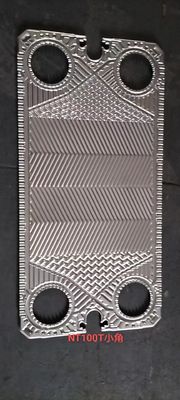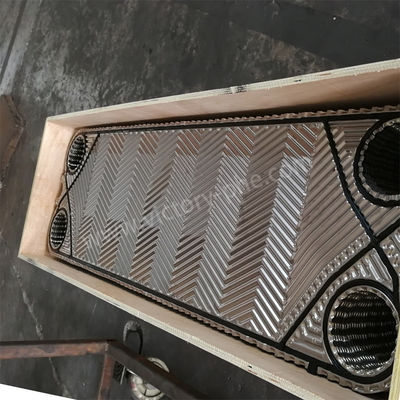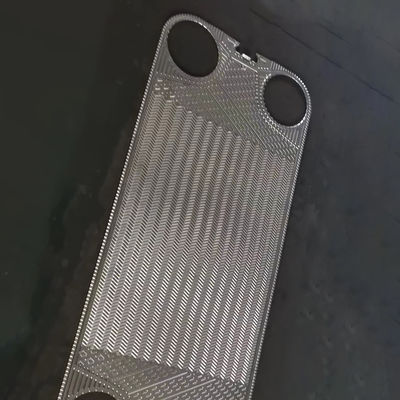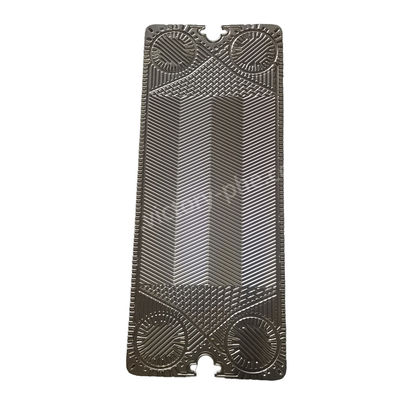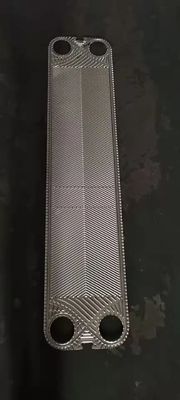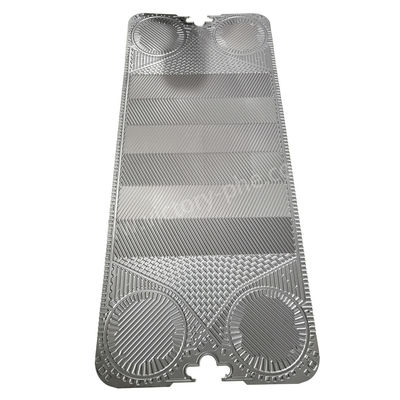Plate heat exchanger is a new type of high-efficiency heat exchanger made of a series of metal plates with a certain corrugated shape stacked together. A thin rectangular channel is formed between the various plates, and heat is exchanged through the plates. Plate heat exchanger is the ideal equipment for liquid-liquid, liquid-vapour heat exchange. It has high heat exchange efficiency, small heat loss, compact and lightweight structure, small footprint, easy installation and cleaning, wide range of applications, long service life and other characteristics.
Plate heat exchanger basic structure and operating principle
Plate heat exchanger type is mainly frame (removable) and brazing type two categories, plate form is mainly zigzag corrugated plate, horizontal straight corrugated plate and tumour-shaped plate three.
Brazed heat exchanger structure
Main structure
⒈ plate heat exchanger plate and plate heat exchanger sealing gasket
Piece of fixed compression plate
3 movable clamping plate
4.Singed clamping bolts
5.Be careful with the upper guide bar
6.Select lower guide bar
7.Borrow Rear Column
A set of plates are stacked to form a package of plates with a channel pattern.
Each end is equipped with an end plate with a receiver.
The whole machine is vacuum brazed.Adjacent channels flow two media. The plates between neighbouring channels are pressed into a corrugated The two media heat exchange is strengthened by a corrugated type. In brazed plate heat exchangers for refrigeration, there is always one more water flow channel than refrigerant flow channel.Principle of operationPlate heat exchanger is a new type of high-efficiency heat exchanger with a certain corrugated shape of the metal plate stacked into the structure, including gaskets, compression plate (movable end plate, fixed end plate) and the framework (on the upper and lower guide bar, the front pillar) composed of gaskets between the plate by the sealing gasket for sealing and conduction, separated from the cold/hot two fluid channels, cold/hot heat transfer medium in their respective channels flow, and heat exchange with the separated plate, to achieve the user's desired temperature. To achieve the user's desired temperature.Each plate has openings at the corners, assembled into a plate bundle to form a fluid distribution pipe and collection pipe, cold/hot media heat exchange, from the respective collection pipe back to the recycling after the return flow.Plates and runnersThere are usually two types of corrugated plates (L small angle and H large angle), which results in three different flow paths (L, M and H), as shown below:L: Small angle A channel made up of adjacent plates with small angles. Low heat transfer coefficient and low resistance. Suitable for high flow rates with weak heat transfer (low specific heat or small temperature difference), e.g. air heat transfer at ambient pressure.
H: Large angle Channel made up of adjacent plates with large angles. High heat transfer coefficient and high resistance. Suitable for small flow rates but strong heat transfer (high specific heat, with phase change or large temperature difference), e.g., phase change heat transfer of refrigerants.
M: Channel A channel consisting of adjacent plates with large/small angles. Heat transfer coefficients and resistance are intermediate between H and L channels.
Choose between these three types of channels and make and select the sizes according to the particular working conditions.
Theoretically, a heat exchanger can mix different types of flow channels, such as H type followed by M type.
However, for the case of phase change, this will lead to the first H flow channel and the last M flow channel between the distribution of the media is out of order, therefore, in all types of refrigeration with BPHE is not used.
Parallel versus diagonal flow:
Advantages of parallel flow: one plate & one gasket, the same plate in a plate set, rotated by 180º can be used for the second side of the channel with little loss of spare parts. The diagonal flow fully meets all the functions of the diagonal flow, with higher design pressures or the use of thinner plates without cross outlets.
About plate materials
Stainless steel: refers to the resistance of air, steam, water and other weak corrosive media and acid, alkali, salt and other chemical corrosive media of steel, also known as stainless acid-resistant steel. In practice, the steel that is resistant to weak corrosive media is often called stainless steel, and the steel that is resistant to chemical media is called acid-resistant steel. There are some differences in the chemical composition of the two, the former is not necessarily resistant to chemical media corrosion, while the latter are generally stainless. The corrosion resistance of stainless steel depends on the alloying elements contained in the steel.
Corrosion resistance mechanism: chromium is the basic element of stainless steel to obtain corrosion resistance, when the amount of chromium in the steel reaches 12% or so, chromium and corrosive media in the role of oxygen, the formation of a thin layer of oxide film on the surface of the steel (since the passivation film Cr2O3), extremely difficult to dissolve in water, can further prevent the oxygen corrosion with iron. Similarly, the destruction of the passivation film Cr2O3 means the destruction of its ability to resist oxygen corrosion.
In addition, the halogenated elements in the corrosive medium (such as chlorine ions commonly found in water) can replace Cr under certain conditions, so stainless steel will rust under certain conditions, in the medium containing acids, alkalis and salts will also be corroded. Therefore, the size of the corrosion resistance of stainless steel is with the chemical composition of the steel itself, plus mutual state, the use of conditions and environmental media type and change. Stainless steel corrosion in water is mainly due to chloride ions in water.
Stainless steel in the rest of the added elements also play a different role. Like Mo will offset the corrosion caused by chloride ions to a certain extent, but there is also a scope of application.
Commonly used stainless steel: 304, 316 belongs to the austenitic stainless steel, its grade for the abbreviation of the foreign call (generally imported), for the 300 series.
Characteristics and conditions of use of commonly used materials for plate supplement
Evaluation of the material corrosion resistance is a good or bad indicator of "resistance to local corrosion equivalent PRE" value is greater the better the corrosion resistance. Mainly Cr, MO, Ni content decision.
1)304 stainless steel: used in organic and inorganic media, concentration<30% temperature<=100/concentration﹥30% temperature﹤50 nitric acid temperature﹤100 various concentrations of carbonic acid, ammonia and alcohols. 304L material is basically the same as 304 material, weldability is better, and can be used as a welded heat exchanger.
2)316
2)316L natural cooling water, cooling tower water, softened water, carbonic acid, acetic acid and caustic soda solution with a concentration of less than 50%, solvents such as alcohols and acetone, dilute nitric acid (﹤20%) and dilute phosphoric acid (﹤30%) with a temperature of less than 100 degrees, but it is not suitable for sulphuric acid. 316 is basically the same as it.
3) 317 is suitable for more conditions of use than 316L.4) AISI904L and SUS890L are cost-effective and better than the above materials.Particularly suitable for general sulphuric acid, phosphoric acid and halides.
SMO 254 advanced stainless steel, increased MO content, is a super stainless steel to improve the 316.Has excellent resistance to chloride and crevice corrosion.Suitable for salt water, inorganic acids.6) SMO654 is a better material than 254 and can be used for cold seawater.(7) RS-2 (0Cr20Ni26Mo3Cu3Si2Nb) stainless steel, which is the domestic equivalent of 316, better resistance to stress corrosion, can be used for more than 80 degrees of concentrated sulfuric acid.(Concentration 90% - 98%)About plate heat exchanger gasketGasket as a heat exchanger plate plate between the sealing element, is to prevent the plate leakage. The quality of the gasket intuitively affects the quality and image of the heat exchanger. In the HVAC industry, gaskets are mainly rubber products, which are greatly affected by temperature and medium, and therefore are greatly affected by the formula, the uniformity of the components, and the conditions of vulcanisation and setting during the production process.
Requirements for gaskets: (the following recommendations do not target any brand and do not take a position)
1, the formula is scientific, must have anti-aging, tear resistance, high resilience characteristics (reduce the reaction force caused by elasticity, the plate is not easy to deform).
2, sealing contact surface size is accurate, alarm signal hole sensitive.
3, bonding-free structure, easy to disassemble and install.

 Your message must be between 20-3,000 characters!
Your message must be between 20-3,000 characters! Please check your E-mail!
Please check your E-mail!  Your message must be between 20-3,000 characters!
Your message must be between 20-3,000 characters! Please check your E-mail!
Please check your E-mail! 
